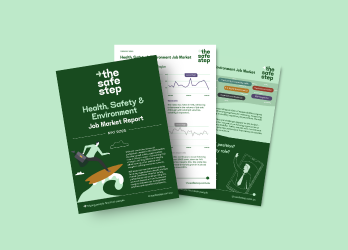Creating a safe space for your HSE team
Page Published Date:
November 9, 2023
Crafting a safe space for your HSE team
As a HSE manager your daily mission centres on the health, safety and wellbeing of your organisation. However, just like the plumber with leaky pipes, it’s not uncommon to unintentionally overlook risks that exist closer to home.
Creating a psychologically safe space for HSE teams doesn’t just happen by chance. It requires managers and leaders to step up, allocate time and apply their expertise. In doing so, you can foster a team environment where individuals feel comfortable speaking up, making mistakes and being themselves at work. This not only cultivates a productive and thriving atmosphere, it sets a powerful example for the rest of the organisation. With your team functioning harmoniously, they are in the best possible position to help everybody else.
In this article, we explore strategies and insights shared by behavioural consultant Alastair Milne at a recent The Safe Step forum, designed to support health and safety professionals create psychologically safe HSE teams.

Psychological safety
Psychological safety is the bedrock of open and effective communication within any team. It's the assurance that individuals won't be punished or humiliated for speaking up, asking questions, or admitting mistakes.
Open communication thrives in a psychologically safe environment. Individuals feel comfortable sharing their thoughts, concerns, and innovative ideas, knowing that their contributions will be valued and considered. This sense of safety nurtures trust, encourages collaboration, and ultimately leads to thriving workplaces.
9 ways HSE leaders can create a psychologically safe team environment:
1. Show vulnerability
As a leader, your actions and words set the tone. Be open, vulnerable, and demonstrate that it's okay to make mistakes. When team members see you acknowledging your own fallibility, they'll feel safer to do the same.
Behavioural consultant Alastair Milne says there is great value in the team hearing you say “I don’t know,” or “I’ll need help with this.” and “How will we achieve this together?” Being comfortable with uncertainty creates room for other people to grow or express doubt. Involving the team in finding a solution creates autonomy.
2. Ask powerful questions
Great leaders are expert at prompting open dialogue. Rather than expressing your own perspective, try to facilitate discussion and ask empowering, open-ended questions. It’s worth having a set of ‘go to’ questions in your leadership tool box. Those who wanting to brush up on their questioning skills should read books [does Alastair have any suggested titles?] and study professional podcasters and interviewers.
Recognise and appreciate team members for bringing questions or ideas to the table. Expressing gratitude and acknowledging their input creates a positive and inclusive atmosphere.
Milne also recommends creating structures or formats for communication that give everyone a voice. You can change the meeting setup, such as going around the table one week and using alphabetical order the next, ensuring that everyone has an opportunity to be heard. Be aware, however, that over-consultation can sometimes create unnecessary complexity. Keep conversations productive. There’s a time for listening and a time for directive leadership.
People have different comfort levels when it comes to sharing their thoughts and feelings. Some may prefer to write it down, while others might benefit from tools like Mentimeter. Providing options empowers your team to share in a way that suits them best.
3. Lead by listening
Make sure your team knows that their opinions and ideas are valued. Create regular opportunities for discussion, brainstorming, and feedback. Listen actively and avoid interrupting team members when they are sharing their thoughts.
As a behavioural consultant, Milne appreciates the value of body language. Open arms, relaxed posture and appropriate eye contact can signal that what you are hearing really matters. “Even a little nod of the head can be helpful,” he says.
Keep an open mind and be attentive to what people are thinking or learning. Responding productively means not passing judgment or pressing people to justify their feelings.
The team may also feel more comfortable if you connect with them on a human scale. “Break that poker face façade. Get to know who your people really are and how they're feeling,” Milne suggests.
4. Destigmatise mistakes
While it might sound counter-intuitive, Milne is a firm believer in celebrating what he calls ‘intelligent failure’ which refers to mistakes that result in useful learning. By emphasising the growth opportunity, you allow your team to move forward more wisely. “Failure is something we’re naturally scared of, but it’s important to destigmatise and learn from it,” he says.
Being non-judgmental is important for psychological safety. When team members haven't taken certain actions, it's essential to explore the reasons behind it without shaming them. "Shame" and "visible disappointment" can hinder open communication, so it's crucial to provide support and understanding instead.
5. Address uncertainty
Uncertainty is a constant companion in the world of work. Recognise this and reassure your team by acknowledging the uncertainties they face. It can be helpful to say things like “This project might get complicated, but that’s OK.”
Openly discussing uncertainties creates an atmosphere where team members feel safe expressing their own concerns.
Convey humility by admitting that you don't have all the answers. This encourages team members to share their perspectives but also establishes a culture of shared learning.
6. Set clear boundaries
It's important to set clear rules for how everyone should behave in your team and make sure these rules are well-known. Co-design these where appropriate.
If someone doesn't follow the rules, it's essential to address the issue in a clear and constructive way. This approach helps everyone understand what's expected in terms of their behaviour and keeps the environment safe for sharing ideas and concerns.
It's like having a road map for how you should work together, making sure everyone is on the same page and can work effectively and respectfully.
7. Celebrate effort & success
Acknowledge and appreciate team members' hard work and contributions, regardless of the outcome. Celebrate not just the wins but also the effort put into achieving them.
Do, however, be careful what you praise. “We often praise people for going above and beyond, waiting weekends, working long hours... What does that say to everybody else in the team?” asks Milne, warning that heavy workloads and unrealistic goals can have unintended consequences for some people.
8. Articulate impact
Explain the significance of your team's work and how it contributes to the organisation. This not only motivates your team but also reinforces the value of their contributions.
When they understand the real impact of what they do, it motivates them and helps them see the value they bring. They play a vital role in making sure everyone goes home just as they arrived, or even better. This sense of purpose boosts their commitment to the job.
9. Continuous Improvement
Regularly gather feedback from your team about the work environment and your leadership. Use this feedback to make improvements and demonstrate that you value their input.
Ask “What is one thing I can do, or stopping doing, to improve your experience of work?”
Remember, as a leader, it's not about you; it's about them. Your goal is to make things better for your team and use their suggestions to improve how things are done.
How we can help
If you would like support building your own HSE leadership capabilities, or want support building your team please talk to one of The Safe Step team. We collaborate with senior consultants who can assist with leadership mentoring and training.
After all, creating a safe space for your HSE team empowers them to excel in their mission of keeping people safe and well, and protecting lives.
Or, if you find yourself working in an organisation that’s not creating right environment for you, our team can assist you in taking the next step, with an emphasis on achieving a great cultural fit.




